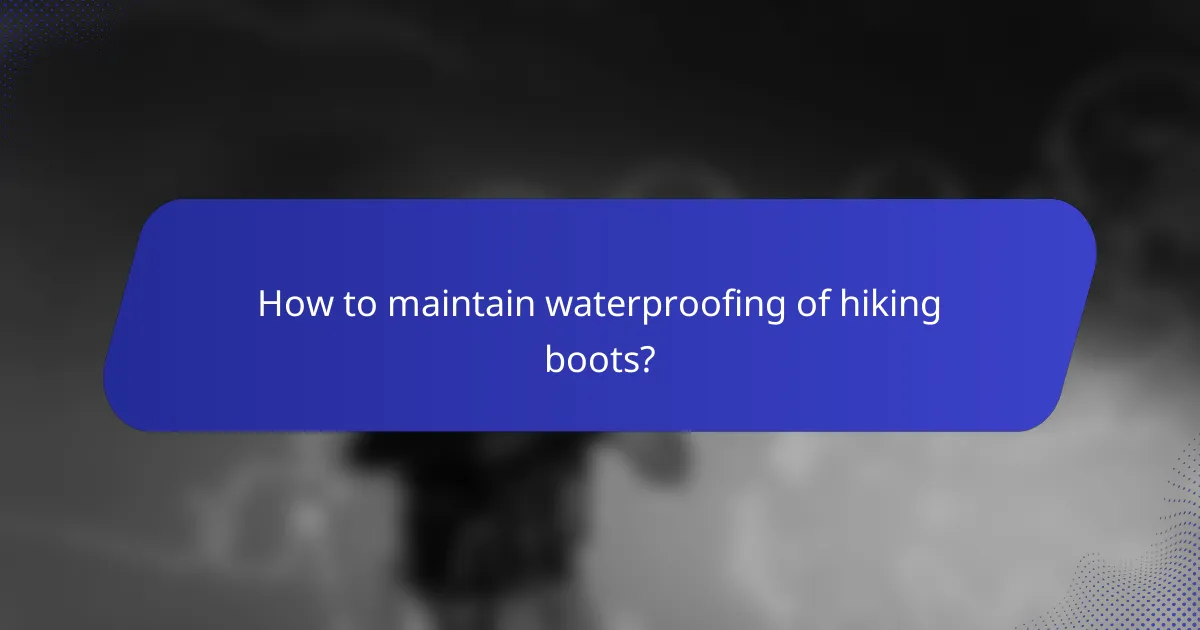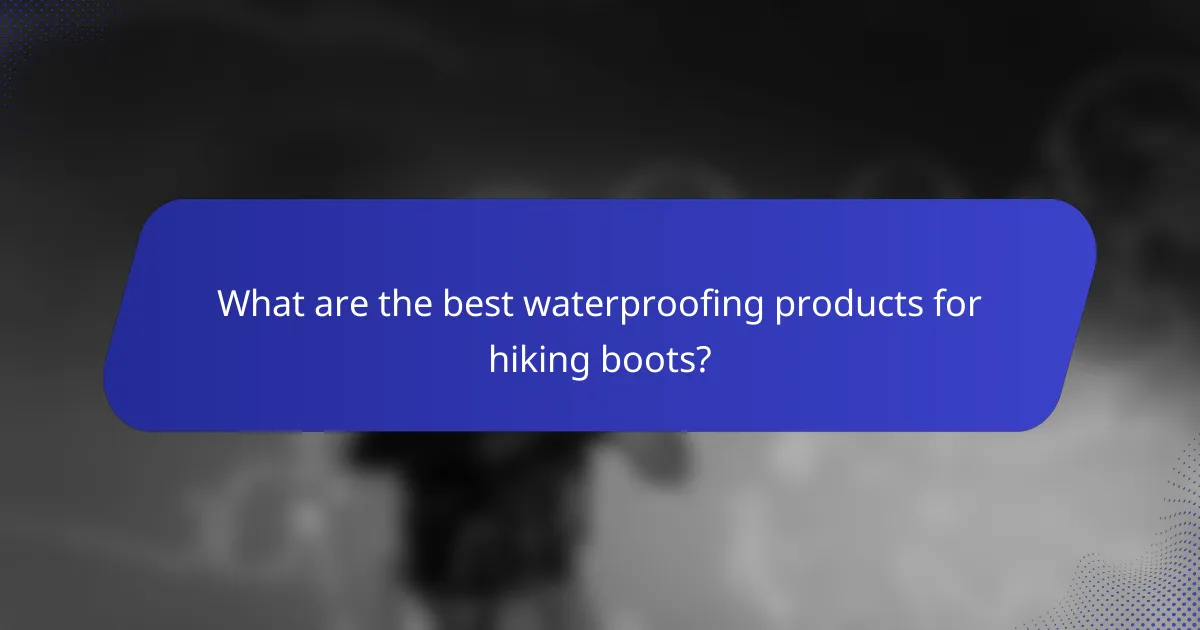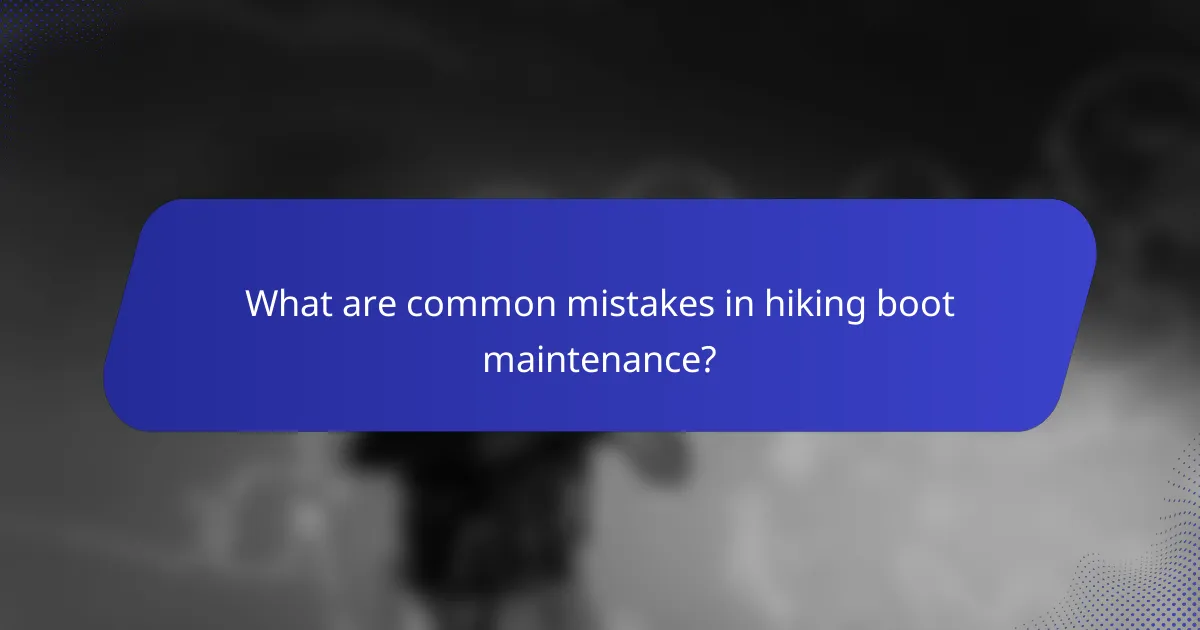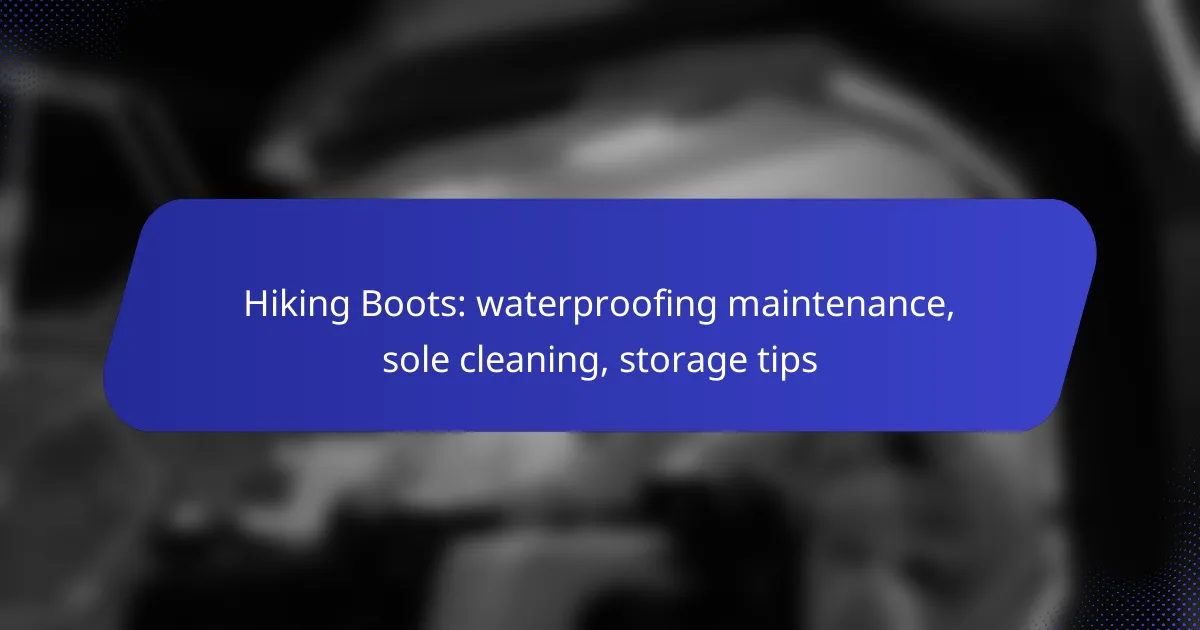Proper maintenance of hiking boots is crucial for ensuring comfort and durability on the trails. This includes regular waterproofing treatments, thorough cleaning of the soles to maintain traction, and careful storage to preserve their shape and materials. By following these tips, you can extend the life of your hiking footwear and enjoy many more adventures.

How to maintain waterproofing of hiking boots?
Maintaining the waterproofing of hiking boots is essential for keeping your feet dry and comfortable during outdoor activities. Regular care and the right products can significantly extend the life of your boots’ waterproof features.
Use specialized waterproofing sprays
Specialized waterproofing sprays are designed to create a protective barrier on the surface of your hiking boots. These sprays typically contain silicone or fluoropolymer compounds that repel water while allowing the material to breathe.
To apply, clean your boots thoroughly, then hold the spray about 6-8 inches away and coat the surface evenly. Reapply every few weeks or after exposure to heavy rain or wet conditions for optimal results.
Apply wax or cream treatments
Wax or cream treatments can enhance the waterproofing of leather hiking boots. These products penetrate the material, providing a durable layer of protection against moisture.
Before application, ensure your boots are clean and dry. Use a soft cloth to apply a thin layer of wax or cream, focusing on seams and creases. Buff the surface after application to ensure even coverage and to restore shine.
Regularly clean and dry boots
Cleaning your hiking boots regularly is crucial for maintaining their waterproofing. Dirt, mud, and salt can degrade the materials and compromise their ability to repel water.
After each hike, remove dirt with a soft brush and rinse with lukewarm water. Allow your boots to air dry at room temperature, avoiding direct heat sources, which can damage the materials.
Store in a cool, dry place
Proper storage is vital for preserving the waterproofing of hiking boots. Store them in a cool, dry area away from direct sunlight and heat sources to prevent material degradation.
Consider using a boot tree or stuffing them with newspaper to help maintain their shape. Avoid storing them in damp areas, as moisture can lead to mold and mildew, further compromising their waterproof capabilities.

What are effective methods for cleaning hiking boot soles?
Cleaning hiking boot soles is essential for maintaining traction and prolonging the life of your footwear. Effective methods include using a soft brush, soaking in warm soapy water, and scrubbing with a toothbrush for stubborn grime.
Use a soft brush for dirt removal
Start by using a soft brush to remove loose dirt and debris from the soles of your hiking boots. A brush with synthetic bristles works well to dislodge mud and small stones without damaging the material.
Make sure to brush both the treads and the sides of the soles to ensure a thorough clean. Regularly removing dirt prevents it from hardening and makes subsequent cleaning easier.
Soak in warm, soapy water
After brushing, soak the soles of your hiking boots in warm, soapy water for about 15 to 30 minutes. Use a mild detergent to avoid damaging the materials.
This soaking process helps to loosen any remaining grime and makes it easier to clean. Ensure that the water does not reach the upper parts of the boots, especially if they are not waterproof.
Scrub with a toothbrush for stubborn grime
For any stubborn grime that remains after soaking, use an old toothbrush to scrub the affected areas. The bristles can reach into the grooves of the treads, effectively removing dirt that a brush might miss.
Apply gentle pressure while scrubbing to avoid damaging the soles. Rinse thoroughly with clean water after scrubbing to remove any soap residue.

How should hiking boots be stored for longevity?
To ensure the longevity of hiking boots, proper storage is essential. Storing them correctly helps maintain their shape, materials, and overall performance for future hikes.
Keep in a breathable bag or box
Using a breathable bag or box is crucial for storing hiking boots. This allows air circulation, preventing moisture buildup that can lead to mold or odor. Look for storage options made from natural materials like cotton or canvas.
Avoid plastic containers, as they trap moisture and can damage the boots over time. If you have multiple pairs, consider labeling each bag or box for easy identification.
Avoid direct sunlight exposure
Direct sunlight can degrade the materials of hiking boots, causing them to fade and crack. Store your boots in a cool, dark place to protect them from UV rays. A closet or a dedicated storage area is ideal.
If you must store them in a sunny location, use a cloth or cover to shield them from light. This simple step can significantly extend the life of your footwear.
Remove insoles for air circulation
Removing the insoles when storing hiking boots enhances air circulation and helps them dry out completely. This practice reduces the risk of unpleasant odors and moisture-related issues.
Make it a habit to take out the insoles after each use, especially if the boots were worn in wet conditions. Allow both the boots and insoles to air out separately before storage.

What are the best waterproofing products for hiking boots?
The best waterproofing products for hiking boots include specialized waxes and sprays designed to enhance water resistance and prolong the life of your footwear. Key factors to consider are the material of your boots, ease of application, and the level of protection needed for your hiking conditions.
Nikwax Waterproofing Wax
Nikwax Waterproofing Wax is a popular choice for leather hiking boots. It penetrates the leather to provide a durable water-repellent finish while maintaining breathability. Application is straightforward; simply clean the boots, apply the wax evenly, and heat it with a hairdryer to activate the waterproofing properties.
This product is environmentally friendly and does not contain harmful solvents, making it a safe option for both users and the environment. Regular use can significantly extend the lifespan of your boots, especially in wet conditions.
Granger’s Performance Repel
Granger’s Performance Repel is a spray-on waterproofing solution suitable for both leather and synthetic materials. It creates a protective barrier against water while allowing the material to breathe, which is essential for comfort during long hikes. To apply, simply spray evenly over clean boots and allow them to dry.
This product is particularly effective in humid or rainy climates, providing a strong defense against moisture. It’s advisable to reapply after several washes or if you notice water no longer beads on the surface.
Kiwi Camp Dry Water Repellent
Kiwi Camp Dry Water Repellent is a versatile spray that works well on various outdoor gear, including hiking boots. It forms a protective layer that repels water and helps prevent stains. For best results, apply it in a well-ventilated area and ensure the boots are clean and dry before application.
This product is known for its long-lasting effects, but it may require reapplication after extended exposure to wet conditions. Users should be cautious not to oversaturate the boots, as this can lead to a sticky residue.

What factors affect the lifespan of hiking boots?
The lifespan of hiking boots is influenced by several key factors, including how often they are used, the types of terrain they encounter, and the quality of materials used in their construction. Understanding these elements can help you make informed choices about care and replacement.
Frequency of use
The more frequently you use your hiking boots, the shorter their lifespan will typically be. Regular use can lead to wear and tear on the soles, seams, and waterproofing. For optimal longevity, consider rotating between multiple pairs if you hike often.
As a general guideline, boots used for casual hikes may last several years, while those used for more intense, frequent trekking could require replacement within a year or two. Keep an eye on signs of deterioration, such as cracks or reduced grip.
Terrain type
The type of terrain you hike on significantly impacts the durability of your boots. Rocky, uneven, or abrasive surfaces can cause more damage than smooth, well-maintained trails. Boots designed for rugged conditions often feature reinforced materials to withstand these challenges.
For instance, if you frequently hike in mountainous areas or off-trail, investing in high-quality boots with durable soles and protective features is essential. Conversely, lighter boots may suffice for flat, easy paths.
Quality of materials
The materials used in hiking boots play a crucial role in their lifespan. High-quality leather and synthetic materials typically offer better durability and waterproofing than cheaper alternatives. Look for boots with good stitching and reinforced areas to enhance longevity.
Additionally, consider the sole material; Vibram soles, for example, are known for their durability and traction. Investing in well-constructed boots may incur a higher initial cost but can save money in the long run by reducing the need for replacements.

What are common mistakes in hiking boot maintenance?
Common mistakes in hiking boot maintenance include neglecting waterproofing, improper cleaning, and poor storage practices. These oversights can lead to decreased performance, comfort, and longevity of your boots.
Neglecting waterproofing
Failing to regularly maintain the waterproofing of hiking boots can result in wet feet and discomfort during hikes. It is essential to reapply waterproofing treatments after several uses or after cleaning your boots.
Choose a suitable waterproofing product based on your boot material, whether leather or synthetic. For leather boots, a wax or cream-based treatment is often effective, while synthetic materials may benefit from sprays.
Improper sole cleaning
Not cleaning the soles of your hiking boots can lead to reduced traction and increased wear. Mud, dirt, and debris can accumulate and affect your grip on various surfaces.
To clean the soles, use a stiff brush or a cloth to remove dirt after each hike. For deeper cleaning, soak the soles in warm, soapy water and scrub gently. Make sure to dry them thoroughly to prevent mold and odors.
Poor storage practices
Storing hiking boots in damp or humid environments can cause mold growth and material degradation. Proper storage is vital for maintaining the integrity of your boots.
Store your boots in a cool, dry place, ideally in a breathable bag or box. Avoid leaving them in direct sunlight or inside a car, as extreme temperatures can damage the materials.



